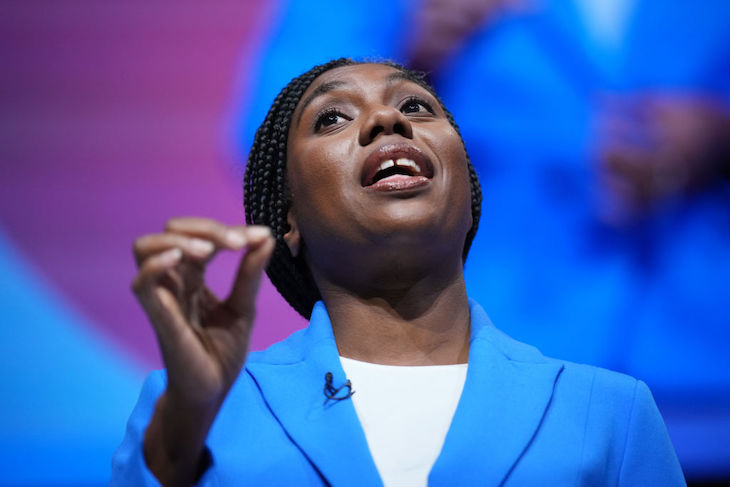Prior to her election as Conservative Leader at the weekend, Kemi Badenoch was, on numerous occasions, compared to Margaret Thatcher. Simon Heffer, under the headline ‘No Tory has ever reminded me more of Mrs Thatcher than Mrs Badenoch,’ claimed that Kemi was ‘hard-minded, deeply principled, and has Mrs Thatcher’s vital grasp of what Rab Butler called “the art of the possible.”’ Tony Sewell spoke of her ‘Thatcher-like determination: “Because I believe this is right, I’m going to do it,” and said that today’s ‘biased and self-serving’ Civil Service was as much a dragon for her to slay as overweening Trade Union power had been for Mrs Thatcher in the eighties. Mark Dolan of GB News this weekend underlined the parallels, joking, ‘Thatcher was the Iron Lady, Kemi has balls of steel.’
The new leader has wisely distanced herself from such comparisons
The new leader, meanwhile, has wisely distanced herself from such comparisons: ‘I’m not Maggie. I’m not a chemist. I’m Kemi. I’m an engineer.’
Nevertheless, it’s interesting to look back through The Spectator‘s archive to see how the election of Thatcher was reported in 1975, and whether this has any light to shine on the present day. True, circumstances were different: Thatcher, far from being an obvious frontrunner, was thought little more than an also-ran when, after Ted Heath’s two election defeats in 1974, it was clear many in the Party were getting sick of their organ-playing, ocean-going leader.
Following the widespread industrial unrest, pay freezes and price controls of the banished Heath government, it was clear a completely new Conservatism was called for. Yet only after Tory grandee Edward du Cann ruled himself out of standing – for marital reasons – and Torch-Bearer of the Right Keith Joseph shot himself in the foot (with his notorious ‘human stock’ speech in Edgbaston, October ’74) did Thatcher put herself forward. ‘If you’re not going to stand, I will,’ she told the departing Joseph, ‘Because someone who represents our viewpoint has to stand.’ Her husband Denis was far from joyful: ‘You must be out of your mind,’ she recalled him saying. ‘You haven’t got a hope.’
Yet it was just this apparent hopelessness which campaign manager Airey Neave so cleverly, even deviously, exploited, to get her elected: ‘Jolt [Ted] by voting for Margaret,’ he told wavering supporters. ‘She won’t win, but she’ll give him a fright.’
Almost no one in the media supported Thatcher before the first ballot. Mrs Thatcher, the Economist said (speaking for many) was ‘precisely the sort of candidate who ought to be able to stand, and lose harmlessly.’ For Bernard Levin in the Times, it was Thatcher’s frostiness – worse, in his opinion, even than Heath’s – that made her unelectable: ‘There is no point in the party jumping out of the igloo and onto the glacier.’ Only The Spectator came out for Thatcher from the outset – in particular Patrick Cosgrave, its political editor.
Cosgrave was something of a character. Irish-born, thrice-married, a lapsed Catholic prone to the odd drink (and then some), a man constantly teetering on the edge of bankruptcy, he was nevertheless the canniest reader of political runes.
On 14 December 1974, two months before the leadership vote, Cosgrave wrote of Thatcher possessing a ‘quality of courage and endurance under fire’ that the Conservative Party so sorely needed ‘in its own struggle to win,’ and described her as ‘the foremost Tory in the country.’ Some of her faults Cosgrave was clear-eyed about: while recognising she had a ‘remarkably retentive memory, a quick logical intelligence, and the capacity to freeze a critic,’ she did sometimes respond with ‘an aggression that did not always serve her purpose; and she did not always seem to grasp that she was damaging herself thereby.’
But, for the moment, these were small objections. Mrs Thatcher had proved a highly competent Education Minister and Shadow Secretary of State for the Environment. She was also a brilliant performer in the Commons, quick with a comeback and regularly bloodying the nose of Labour Chancellor Denis Healey, a famous bruiser himself. On 1 February 1975, three days before the contest, a leading article in The Spectator argued that, having declared her candidacy some ten days before, she had ‘come to the fore as a challenger for the Conservative leadership’ and ‘emerged as a heavyweight candidate’ with ‘a distinct chance of winning.’
Mrs Thatcher, the piece went on, had ‘many of the attributes that the Conservative Party now most desperately needs in a leader…. She is a parliamentary debater of the utmost force, precision and wit.’ But ‘perhaps more important than any of these attributes, she has a definite understanding of the kind of Conservatism which the nation needs, and she would articulate it forcefully and with courage…’
‘What, then,’ the article ended, ‘are the Tories dithering about?’
They were not to dither much longer. On the first ballot she received 130 votes to Heath’s 119. On the second, following the ex-leader’s glowering departure, Mrs Thatcher, standing against colleagues like Jim Prior, Willie Whitelaw and Geoffrey Howe, received 52.9 per cent. The age of Thatcher – set to endure a decade and a half – had now begun.
Cosgrave was beside himself. In ‘Britain’s “second lady”’, an article published a few days later, he crowed that ‘the election of Mrs Margaret Thatcher as leader’ had given the party ‘after more than two years of ineffectiveness and decline, a new chance.’ It was Thatcher’s ‘directness, toughness and honesty’ which had won it, her ‘clear determination – and ability – to reclaim for the cause natural and hitherto loyal Conservative voters who have drifted away…’
Amidst the merriment and plain relief, a note of caution should be sounded
Despite the country’s most obvious problems – inflation, a high mortgage rate, seemingly incessant industrial strife – solutions would ‘come the better and the more readily from a leader who is obviously and sincerely a thinking and believing Conservative, who knows what has gone wrong, and who knows how to put it right. The party could hardly have chosen better: the quarrels of the recent past can now be put behind it, and a new future can begin.’
This upbeat note would be pleasant to end on, particularly as the outcome of last weekend’s leadership election was what so many of us hoped for, and for so long. But amidst the merriment and plain relief, a note of caution too should be sounded. Kemi Badenoch has asserted repeatedly of late that the Party must – before it even thinks of formulating policy – reestablish its core principles. Given that, it’s another article from Cosgrave, ‘Getting the Priorities Right’ (January 1975), which seems most pertinent:
‘It is the conviction that she stands for something recognisable as Conservatism which has gained so much support for her in recent weeks,’ he wrote of Mrs T. ‘Unless it is different, the Tory Party is nothing… But it cannot be too often said that, until the party decides where it wants to go, and what it stands for, it is unlikely to get any votes at all.’
Something for Kemi and her newly assembled Shadow Cabinet to ponder in the weeks and months ahead. The late, great Patrick Cosgrave, you can’t help feeling, would have raised a brimming glass to Mrs Badenoch, wishing her the best of Irish-British luck.
Watch more on SpectatorTV:







Comments